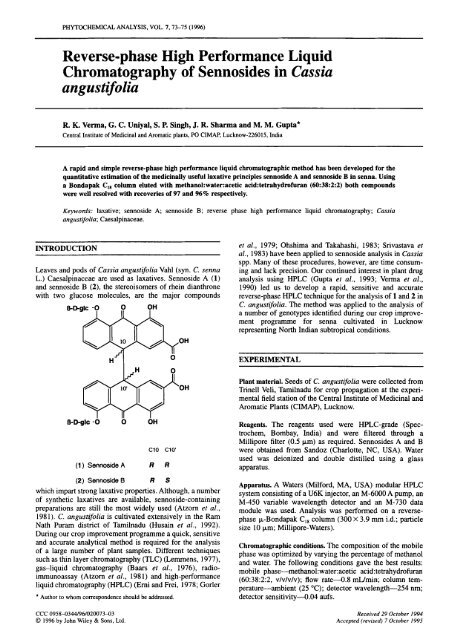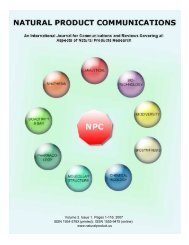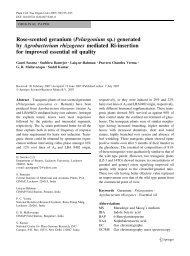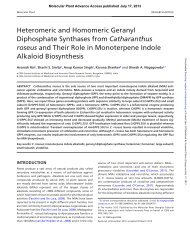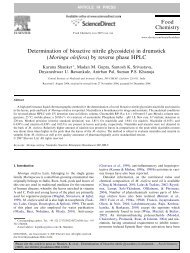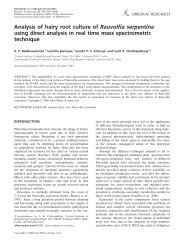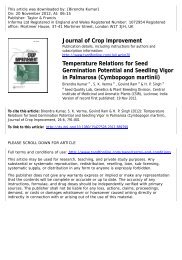Reverse-phase High Performance Liquid ... - CIMAP Staff
Reverse-phase High Performance Liquid ... - CIMAP Staff
Reverse-phase High Performance Liquid ... - CIMAP Staff
You also want an ePaper? Increase the reach of your titles
YUMPU automatically turns print PDFs into web optimized ePapers that Google loves.
PHYTOCHEMICAL ANALYSIS, VOL. 7.73-75 (1996)<br />
<strong>Reverse</strong>-<strong>phase</strong> <strong>High</strong> <strong>Performance</strong> <strong>Liquid</strong><br />
Chromatography of Sennosides in Cassia<br />
angustifolia<br />
R. K. Verma, G. C. Uniyal, S. P. Singh, J. R. Sharma and M. M. Gupta*<br />
Central Institute of Medicinal and Aromatic plants, PO <strong>CIMAP</strong>, Lucknow-226015, India<br />
A rapid and simple reverse-<strong>phase</strong> high performance liquid chromatographic method has been developed for the<br />
quantitative estimation of the medicinally useful laxative principles sennoside A and sennoside B in senna. Using<br />
a Bondapak C,, column eluted with methano1:water:acetic acid:tetrahydrofuran (60:38:2:2) both compounds<br />
were well resolved with recoveries of 97 and 96% respectively.<br />
Keywords: laxative; sennoside A; sennoside B; reverse <strong>phase</strong> high performance liquid chromatography; Cassia<br />
angustifolia; Caesalpinaceae.<br />
INTRODUCTION<br />
Leaves and pods of Cassia angustifolia Vahl (syn. C. senna<br />
L.) Caesalpinaceae are used as laxatives. Sennoside A (1)<br />
and sennoside B (2), the stereoisomers of rhein dianthrone<br />
with two glucose molecules, are the major compounds<br />
D-Dglc -0<br />
I<br />
0 OH<br />
II I<br />
et al., 1979; Ohshima and Takahashi, 1983; Srivastava et<br />
al., 1983) have been applied to sennoside analysis in Cassia<br />
spp. Many of these procedures, however, are time consuming<br />
and lack precision. Our continued interest in plant drug<br />
analysis using HPLC (Gupta et al., 1993; Verma et al.,<br />
1990) led us to develop a rapid, sensitive and accurate<br />
reverse-<strong>phase</strong> HPLC technique for the analysis of 1 and 2 in<br />
C. angustifolia. The method was applied to the analysis of<br />
a number of genotypes identified during our crop improvement<br />
programme for senna cultivated in Lucknow<br />
representing North Indian subtropical conditions.<br />
woH<br />
EXPERIMENTAL<br />
Plant material. Seeds of C. angustifolia were collected from<br />
Trine11 Veli, Tamilnadu for crop propagation at the experimental<br />
field station of the Central Institute of Medicinal and<br />
Aromatic Plants (<strong>CIMAP</strong>), Lucknow.<br />
B-Dglc -0 0 OH<br />
c10 c10<br />
(1 ) Sennoside A R R<br />
(2) Sennoside B R S<br />
which impart strong laxative properties. Although, a number<br />
of synthetic laxatives are available, sennoside-containing<br />
preparations are still the most widely used (Atzorn et al.,<br />
1981). C. angustifolia is cultivated extensively in the Ram<br />
Nath Puram district of Tamilnadu (Husain ef al., 1992).<br />
During our crop improvement programme a quick, sensitive<br />
and accurate analytical method is required for the analysis<br />
of a large number of plant samples. Different techniques<br />
such as thin layer chromatography (TLC) (Lemmens, 1977),<br />
gas-liquid chromatography (Baars et al., 1976), radioimmunoassay<br />
(Atzorn et al., 1981) and high-performance<br />
liquid chromatography (HPLC) (Erni and Frei, 1978; Gorler<br />
* Author to whom correspondence should be addressed.<br />
CCC 0958-0344/96/020073-03<br />
0 1996 by John Wiley & Sons, Ltd<br />
Reagents. The reagents used were HPLC-grade (Spectrochem,<br />
Bombay, India) and were filtered through a<br />
Millipore filter (0.5 km) as required. Sennosides A and B<br />
were obtained from Sandoz (Charlotte, NC, USA). Water<br />
used was deionized and double distilled using a glass<br />
apparatus.<br />
Apparatus. A Waters (Milford, MA, USA) modular HPLC<br />
system consisting of a U6K injector, an M-6000 A pump, an<br />
M-450 variable wavelength detector and an M-730 data<br />
module was used. Analysis was performed on a reverse<strong>phase</strong><br />
p-Bondapak C,, column (300 X 3.9 mm id.; particle<br />
size 10 pm; Millipore-Waters).<br />
Chromatographic conditions. The composition of the mobile<br />
<strong>phase</strong> was optimized by varying the percentage of methanol<br />
and water. The following conditions gave the best results:<br />
mobile <strong>phase</strong>-methano1:water:acetic acid:tetrahydrofuran<br />
(60:38:2:2, v/v/v/v); flow rate4.8 mumin; column temperature-ambient<br />
(25 "C); detector wavelength-254 nm;<br />
detector sen sitivity4.04 aufs .<br />
Received 29 October 1994<br />
Accepted (revised) 7 October 1995
74<br />
R. K. VERMA ET AL.<br />
B<br />
A 2<br />
d.<br />
Calibration graphs. Standard solutions (1 mg/lO mL) of 1<br />
and 2 were prepared in methanol. Different amounts of<br />
these standards were injected into the HPLC using the<br />
chromatographic conditions described above. The area<br />
counts of peaks (y) and the corresponding concentrations (x)<br />
were used to plot the calibration graphs. The graphs were<br />
linear in the range of 2-50kg for both 1 and 2. The<br />
regression equations were y= 53.15x+ 2 1.3(r= 0.99) for<br />
sennoside A (1) and y=152.05x+22.1 (r=0.99) for sennoside<br />
B (2).<br />
Extraction procedure. Samples of plants of different genotypes<br />
(1 .O g each) were finely powdered and extracted with<br />
water (3 X 25 mL each). The extracts thus obtained were<br />
made up to 100mL with water. Samples were filtered<br />
through a Millipore filter (0.5 km) and a known amount of<br />
each extract was subjected to HPLC analysis under the<br />
above conditions. The contents of 1 and 2 were calculated<br />
using calibration graphs of each compound.<br />
RESULTS AND DISCUSSION<br />
Different compositions of the mobile <strong>phase</strong> were tested<br />
and the desired resolution of the sennosides with symmetrical<br />
and reproducibile peaks and a stable baseline was<br />
achievedby using methanol: water: acetic acid: tetrahydrofuran<br />
(60:38:2:2) as mobile <strong>phase</strong> (Fig. 1). Peaks corresponding to<br />
sennoside A (1) and sennoside B (2) were sharp and well<br />
resolved with retention times of 9.88 and 7.22 min respectively.<br />
The resolution factor between the two peaks was<br />
0.52. As an effective measure of column performance, the<br />
number of theoretical plates for 1 and 2 were 579 and 1084,<br />
respectively. Recoveries of sennoside A and sennoside B<br />
were calculated by spiking the extract with a stock solution<br />
in the mobile <strong>phase</strong> and were found to be 97% and 96%,<br />
respectively. The sennoside contents in different genotypes<br />
of senna cultivated in Lucknow are given in Table 1.<br />
In conclusion, the HPLC method described here is<br />
efficient and simple for the separation and determination of<br />
sennoside A and sennoside B in plant extracts. The method<br />
is an improvement over previous methods since the<br />
retention times of both compounds is reduced, with<br />
Table 1. Contents of sennoside A and sennoside B in five<br />
genotypes of Cassia angustifolia<br />
Genotype Sennoside A(%)’ Sennoside 61%)’<br />
12-121 2.4420.03 1.0620.03<br />
12-7 1.03*0.02 NDb<br />
<strong>CIMAP</strong>-L 1.2620.01 1.0320.02<br />
G19 1.4920.01<br />
0.88* 0.03<br />
G 27 0.89k0.04 ND<br />
a Percentage composition on dry weight basiskSE: n=5.<br />
ND, none detected.
SENNOSIDES IN CASSIA ANGWSTIFOLIA 75<br />
excellent resolution, which is desirable for column-life and<br />
for assay efficiency.<br />
Acknowledgement<br />
The authors thank Dr. Sushi1 Kumar (Director, <strong>CIMAP</strong>, Lucknow) for<br />
encouragement and facilities extended and Mr. Srikant Sharma for<br />
providing regression equations.<br />
REFERENCES<br />
Atzorn, A, Weiler, E. W. and Zenk, M. H. (1981). Formation and<br />
distribution of sennosides in Cassia angustifolia, as determined<br />
by a sensitive and specific radio-immunoassay.<br />
Planta Med41, 1-14.<br />
Baars, A. J., Vermeulen, R. J. and Breimer, D. D. (1976). Gas<br />
chromatographic determination of the laxative l,&dihydroxyanthraquinone<br />
in urine and faeces. J. Chromatogr.<br />
120,217-220.<br />
Erni, F. and Frei, R. W. (1978). Two-dimensional column liquid<br />
chromatographic technique for resolution of complex mixtures.<br />
J. Chromatogr. 149,561-569.<br />
Gorler, K., Mutter, S. and Westphal, C. (1979). Hochdruckfliissigkeitschromatographische<br />
untersuchungenvon senna<br />
zubereitungen. Planta Med. 37,308-315.<br />
Gupta, M. M., Verma, R. K., Uniyal, G. C. and Jain, S. P. (1993).<br />
Determination of plumbagin by normal <strong>phase</strong> high performance<br />
liquid chromatography. J. Chromatogr. 637, 209-1 12.<br />
Husain, A., Virmani, 0. P., Popli, S. P., Misra, L. N., Gupta, M. M.,<br />
Srivastava, G. N., Abraham, 2. and Singh, A. K. (1992).<br />
Dictionary of Indian Medicinal Plants. pp. 112. <strong>CIMAP</strong>,<br />
Lucknow.<br />
Lemmens, L. (1977). Determination of dihydroxy dianthrones by<br />
densitometry after thin layer chromatographic separation.<br />
J. Chromatogr. 132,363-365.<br />
Ohshima, Y. and Takahashi, K. (1983). Separation method for<br />
sennosides. J. Chromatogr. 258,292-296.<br />
Srivastava, V. K., Maheshwari, M. L. and Mandal, S. (1983). A<br />
rapid high performance liquid chromatography method for<br />
analysis of sennoside in senna. Ind. J. Pharm. Sci., 45,<br />
230-233.<br />
Verma, R. K., Uniyal, G. C. and Gupta, M. M. (1990). <strong>High</strong><br />
performance liquid chromatography of poppy straw. Ind. J.<br />
Pharm. Sci., 52,276-278.


